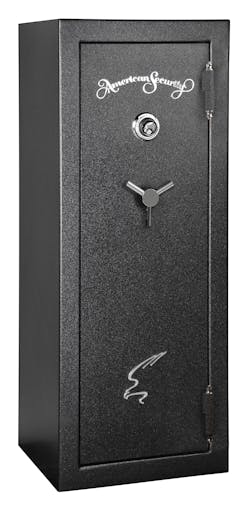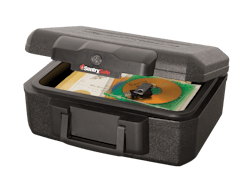Safes are an expanding profitable market, and locksmiths are well-suited for safe work, because safes require labor to deliver and specialized skills to install and service.
When I was focused on serving the retail banking industry, safe work varied but was necessary. Even though we didn’t install large vaults or time locks, we knew who to call to handle them when the situation arose. Servicing safe-deposit boxes, which are inside the vault, was a routine activity. Of course, we also worked on anything else in the bank that had locks, keys, combinations, electric strikes, cameras, door operators, etc.
Banks, like most other clients, want to be able to call one contact and be reasonably sure the issue would be resolved quickly, so that’s what we did to win the business and earn their loyalty. Unlike the typical residential client, commercial customers are likely to bring you repeat business.
We developed a reputation, and safe manufacturers would call us to provide service to their customers. They would be sure to provide the correct drill points necessary to open a safe and the correct repair parts for the job.
UL Safe Testing
UL is the benchmark for safe-performance standards. UL develops the test criteria and monitors adherence to manufacturing or testing requirements.
UL was founded by William Henry Merrill Jr. while he worked at the 1890 Chicago World’s Fair to asses fire risks. There, he presented his idea to form an electrical testing laboratory. The Western Insurance Union and the Chicago Underwriters Association funded his idea and formed what would become Underwriters Laboratory (UL).
UL fire-endurance tests measure the amount of time a safe can withstand certain temperatures while keeping interior temperatures below 350 degrees Fahrenheit. The standards:
UL 1/2-Hour Test: withstands 1,550 degrees F for a half-hour
UL 1-Hour Test: withstands 1,700 degrees F for one hour
UL 2-Hour Test: withstands 1,850 degrees F for two hours
American Security Interview
American Security has produced a full line of safes, sold through locksmith distribution rather than direct to consumers and big-box stores, for 75 years. Locksmith Ledger interviewed A.J. Gibson, national sales manager of American Security about fire-rated safes.
Gibson: Fire ratings in the safe market are some of the most misconstrued, most misrepresented ratings of any industry. Depending on the maker, you might see a safe listed as “factory tested,” “built to UL standards,” “tested by UL” or “verified by UL.” But only safes marketed with a UL-verified logo or ETL Fire testing logo and safes containing an actual UL label applied to the safe body have been independently tested by a lab, and not by the manufacturer. They passed the test, earning them the verification label, which they then have to pay for use. This is an important distinction among safes.
American Security has the following safes that passed such testing:
UL Series Fire & Impact Safe
- UL-tested and verified 120-minute fire protection
BF Series Home Safe
- ETL-tested and verified 120-minute fire protection
- Also UL 1-hour 1,700 degree fire rating for BF1512, 1716 and 2116
BFII Series Gun Safe from American Security
- ETL-tested and verified 120-minute fire protection ·
BFX Series Gun Safe from American Security
- ETL-tested and verified 120-minute fire protection
LL: Are UL-rated safes for commercial or residential applications?
Gibson: The BF, BFX, BFII and UL series safes are used commercially and residentially. Gun collectors and dealers, of course, gravitate to the BFX and BFII series to protect their valuables, but these gun safes can protect much more than guns, including important documents, jewelry, cash, heirlooms and electronics.
The BF is traditionally sold as a home safe, while the UL series was specially designed to withstand a 30-foot drop — equivalent to falling through a two-story burning building. This makes it a popular safe among business owners, including legal service professionals, government officials, manufacturers and specialty retailers and mall shops.
LL: Are there any trends in the market, and can locksmiths successfully compete?
Gibson: Consumers and business owners have become far more security sensitive since the riots in 2020. This has caused the largest demand for safes in all categories: commercial safes, home safes and gun safes.
Of course, the locksmith can compete. That’s the market we put most of our focus on. We provide the locksmith the opportunity to retail all categories of safes under one manufacturer along with many opportunities to participate in large revenue-generating opportunities, such as safe delivery and installation, along with partnering with locksmiths for technical service support of all our products.
LL: What mechanical and electronic safe locks are used?
Gibson: Locks might be your standard combination spyproof dial, biometric, touchscreen, punch button or “smart.” American Security developed the industry’s first retrofit group II electronic safe lock in 1990. (The KPL100 since has been discontinued.) Seven years later, American Security developed the ESL10 and ESL20 electronic safe locks, now considered an industry standard.
LL: Can fire-rated safes be drilled like other styles of safes?
Gibson: Any safe can be drilled successfully if you know where to drill. Drilling through a steel plate and trying to avoid hitting a relocker require the expertise of a locksmith working in partnership with the manufacturer’s in-house tech-services team to guide them. If the door is filled with drywall, it’s, of course, much easier to get through than a safe door filled with concrete or reinforced in other ways that would make penetration a challenge. American Security fills its BF series safes, including the BFX and BFII, with a proprietary concrete mix called DryLight, which provides a seamless fire barrier and makes attacks on the safe that much more challenging.
LL: What items do people get fire-rated safes to protect?
Gibson: Paper typically starts to ignite at 450 degrees F, so to protect important documents, such as house and stock deeds, identity papers and such, people should seek out a safe that has a minimum independently tested and verified fire rating of at least 30 minutes. The more remote your home or business is, the more time it will take a fire crew to reach you, which puts your valuables at risk if not stored properly.
LL: What features are the most important with respect to fire resistance?
Gibson: A fire-resistant safe will have adequate fire protection at the price you’re willing to pay for protection of 30 minutes to two hours, and that will come from the fill type. Drywall and concrete are the most common today.
How well a seal is created between the metal body and the inside fill also is important. Air gaps are the biggest risk to the contents of a safe. The better fire-rated safes also come with an adequate door seal. The best seal is a Palusol door seal that expands to seven times its size when temperatures reach 212 degrees F, which seals off heat and smoke. Some top-end products use dual seals that have a silicone seal as the first defense protecting the safe until the Palusol seal performs its task.
SentrySafe Interview
Founded in 1930, SentrySafe produces and distributes fire-resistant chests, files, safes and security storage containers to more than 54 countries worldwide. The company is affiliated with Master Lock.
Locksmith Ledger interviewed J.P. Benjamins, director of product management, safes at Master Lock.
Locksmith Ledger: How important are the UL listings and product certifications in this market?
Benjamins: UL listings and product certifications, such as ETL Verified, are very important, because they provide an unbiased guide to the consumer on the conditions the fireproof safe is tested and proven to withstand. Unscrupulous sellers will claim their safes have fire or water protection with no verification whatsoever.
All SentrySafe Fire Safes are also ETL verified to protect digital media for their rated time and temperature.
Benjamins: Safes provide another security solution locksmiths can add to their expertise to attract customers. High-end safes that aren’t typically found at retail can provide good business and differentiation to locksmiths.
Although most locksmiths aren’t necessarily equipped to handle intricate safe openings and repairs, many use an internal network to share photos, drill points, safe-opening techniques and many other pieces of valuable safe information to make opening safes and working on safes easier and more efficient.
LL: What kind of mechanical and electronic safe locks are used?
Benjamins: When it comes to mechanical and electronic safes, they’re differentiated in the way the safe is accessed.
For example, SentrySafe carries combination dial and keyed fireproof safes, such as our SFW123CS and 1200 models. These mechanical products feature a manual locking mechanism, while our SFW123GDCSSC and SFW123BTC models require digital access via digital touch pad or biometric (fingerprint) access.
LL: What features are the most important with respect to fire resistance?
Benjamins: UL ratings are a great standardized guide for consumers to figure out what level of fire protection they’re looking for. In general, the larger the structure, the more wood construction, the longer the distance to the nearest fire response and a higher likelihood of wildfires, the more fire protection one should consider.
Other factors prospective safe owners should consider are things such as reliable entry, the locking mechanism and durability.
American Security BFX Series
American Security combines exceptional burglary protection with superior fire protection in its BFX gun safe. The UL-certified BFX gun safe also protects against severe sledgehammer and pry attacks through a 2-inch-thick body, one-half-inch-thick solid steel-plate door, dual reinforced steel door frame and four-way active bolt system.
In addition, its three-stage lock protection includes a one-quarter-inch hardplate, spring-loaded relocker and gear cam housing with precision-engineered lock bolt protection that prevents successful drill attacks.
American Security BFII Series
The BFII series gun safe provides twice the protection of the BFX gun safe with a 2-1/4-inch-thick body, one-half-inch thick solid steel plate door and dual reinforced steel door frame It has 10 1-1/2-inch-wide chrome-plated bolts.
The BFII features American Security’s patented active hardplate design, spring-loaded relocker and gear cam housing with precision-engineered lock bolt protection to repell drill attacks.
American Security BF Series
The BF series of fire and burglary safes comes in a variety of sizes to suit a variety of requirements, so end users can find one that keeps items away from thieves and the destructive power of flame — all in one convenient place.
The BF series earned the UL listed one-hour fire label. The BF’s dual seal design uses a silicone foam seal that includes a heat-expanding Palusol intumescent seal to prevent heat and smoke from reaching the inside.
In addition, the safe’s 2-5/8-inch-thick body, which consists of one-eight of an inch outer and inner steel plates, create a burglary resistant structure that encloses American Security’s proprietary DryLight fire-resistant material.
More info: www.americansecuritysafes.com
SentrySafe 1200
The SentrySafe Privacy Lock Fire Chest 1200 is designed with the end user in mind. The safe is UL classified for one-half-hour protection up to 1,550 degrees F and includes digital-media protection. This is aimed at protecting tablets, phones, external hard drives, memory cards, USB drives, CDs, DVDs and other electronic storage devices.
SentrySafe SFW123GDCThe Sentry Digital Water and Fire Safe SFW123GDC has a backlit keypad and interior lighting to make it easy to access valuables in the dark. The SFW123GDC is aimed at home or business security demands.
More info: www.sentrysafe.com
Gardall Two-Hour series
The Gardall UL Two-Hour fire safes provide two hours of fire protection at 1,850 degrees F. They have a 4-1/4-inch door that has a recessed antipry design and 2-1/2-inch-thick walls.
A solid chrome-plated handle and an independent relocker and hardplate help to prevent forced and drill attacks. In addition, five active1-inch-diameter bolts lock in three directions and extend deep into the safe’s body.
More info: www.gardall.com
Tim O’Leary is an experienced security consultant and a regular contributor to Locksmith Ledger.
About the Author
Tim O'Leary
Tim O'Leary is a security consultant, trainer and technician who has also been writing articles on all areas of locksmithing & physical security for many years.


